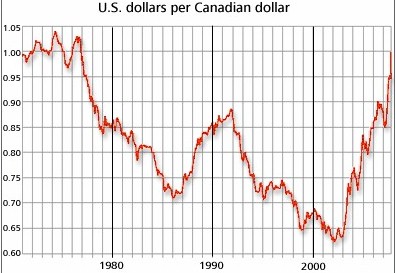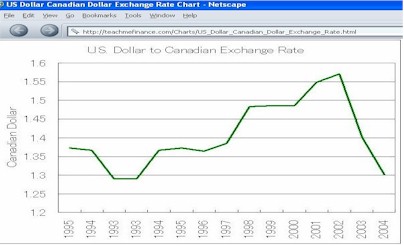Foreign Exchange Topics
last updated 2007 Oct 03

| 4X
Foreign Exchange Topics last updated 2007 Oct 03 |
 |
 |
This web page has audio clips - just click on the icon (like the one to the left) and you can hear Prof. Richardson's voice adding additional information to topics on the page. |  |
turn on your speakers to hear audio clips |
| Higher
Dollar
October 2007 |

image: cbc.ca website October 2007, data: Pacific Exchange Rate Service |
| Higher
Dollar
October 2007 |
"key economic
indicators" of why the Cdn dollar is strong, and may stay strong
|
| Higher
Dollar
October 2007 |
"Some of the
reasons for the Canadian dollar's strength have been around for years.
Commodity prices have been soaring in the last few years. Oil, copper,
gold, wheat — you name the resource and Canada seems to produce and export
it in abundance.
The loonie is also drawing strength from the comparative strength of the Canadian economy. Canada has healthy budget and trade surpluses; the U.S. runs big deficits in both. The Canadian economy is still generating jobs, while the American economy is shedding workers. The Canadian housing picture is also much healthier, with little evidence of the subprime meltdown that's shaken the U.S. The weakness south of the border has the U.S. Federal Reserve slashing interest rates, while the Bank of Canada may soon be raising rates to rein in inflationary pressures. That divergence has been noticed by currency traders. The futures markets show that speculators are increasingly betting that the Canadian dollar will extend its gains.The U.S. dollar, on the other hand, has been limping through historic weakness. It's now at an all-time low against the euro." CBC news on CBC.ca September 20, 2007 |
| Higher
Dollar
October 2007 |
"key economic
indicators" of why the Cdn dollar is strong, and may stay strong
|
| Higher
Dollar
December 2005 |
In December 2005, Prof. Richardson made contact with an old friend and colleague (Murrary Hardie) from Dept. of Foreign Affairs who is now posted as the Consul at the Canadian Consulate in Minneapolis, Minnesota. In the exchange of emails, Tim asked Murrary if he is enjoying the fruits of a higher dollar. Murray's reply is below. You can click on the screen capture of the email to read the full exchange. |

| This
graphic, from Mark McCracken's website,
http://markmccracken.com/ illustrates how the Canadian dollar has steadily gained in strength against the U.S. dollar from 2002 through to the end of 2004, in 2005 the Cdn dollar gained even more on the U.S. The reason the line is going "down" is because this particular chart shows the U.S. value declining as opposed to the Cdn value increasing. |
 |
| The CBC produces "backgrounders" on their web site which allow the readers of their stories to have more "in-depth" information about particular topics. |
Justin Thompson was the CBC
person who interviewed Dr. Bhatia. Parts of Thompson's article, done May
22nd, 2003, are produced below.
| Low
Cdn $ analysis
|
"The fluctuating
dollar"
Justin Thompson, CBC News Online, May 22, 2003 "After dipping to record
low values in 2002, the Canadian dollar has ridden a steep wave to
recovery. Within a 16-month period, the Canadian dollar gained more
than 12 cents US - rising from 61.84 cents in January 2002 to 74.37
cents US in May 2003."
Low Canadian dollar PRO: "A low dollar makes Canadian goods more attractive to foreign buyers and investors. The increased demand drives up production, boosting Canadian manufacturing and creating jobs. Canada exports more than it imports, and a low dollar ensures the surplus continues. A low dollar also encourages tourism, most of which comes from the U.S. It also encourages Canadians to spend their tourist dollars at home." CON: "A low dollar makes import items, including produce and other consumer items, more expensive. It gives Canadian tourists less value for their dollar " |
| Low Dollar | Importing produce is a big
thing for the Canadian consumer. Being a northern country, we import large
quantities of fruits and vegetables 12 months of the year. We produce a
small amount of fruits and vegetables in Southern Ontario, the interior
of B.C. and parts of Quebec and the Maritimes but these amounts are less
than the total national demand. As our Canadian society becomes more demographically
diverse we have been increasing the quantities and varieties of the fruits
and vegetables we import.
WTGR |
| High
Cdn $ analysis
|
High Canadian
dollar
CON: "A high
dollar makes Canadian exports more expensive to foreigners. "So clearly
the exporters would be at a loss unless they hedge themselves," says
Bhatia. With the drop in foreign orders, Canadian manufacturers will
slow production. This slowdown will lead to layoffs and job losses."
|
| High
Cdn $ analysis |
We also have
to watch what a high Canadian collar can do to the automotive industry
- a large part of the economy in Ontario. A large percentage of the cars
made by the Japanese and American manufacturers operating in Ontario, end
up being exported to the U.S.
If our Canadian dollar stays high for a long period of time it might cause the Japanese car companies [Toyota, Honda, Suzuki] to consider moving to Mexico [Nissan did years ago], and cause the American plants to cut back their operations in Oakville and Oshawa. WTGR 2003
Gerry Malloy wrote
Malloy explains that "Toyota has confirmed its intention to increase its production capacity in North America probably for sport-utility vehicles, which are still built mostly in Japan. According to Yoshimi Inaba,... that expansion will take place in the U.S. not in Canada nor Mexico". permission to quote Gerry Malloy given by Mgmalloy@aol.com in an email to WTGR 2005Apr19. Copy kept on file in permissions binder. |
| 2003
October $.75 2003
|
? - will
the dollar go higher
"Clearly the momentum is to push the U.S. dollar weaker and the Canadian dollar should get stronger over the next weeks and months," said Jack Spitz, director of foreign exchange at National Bank of Canada." 2003 Oct 6
World opinion on the U.S. dollar "the president of the European
Central Bank said the United States' worsening trade deficit and soaring
budget deficits means a weaker dollar is unavoidable. "
"...the market doubted the
strength of the U.S. economy and fretted over the size of the U.S. current
account deficit, analysts said."
|
| 2003
October $.75 |
The National
Post reported Oct 7, 2003
"Some analysts are predicting an 80-cent loonie over the next year or so, [which in 2005 proved true] which could squeeze Canadian exporters who have relied for years on a low currency value to compete in U.S. and overseas markets. However, that would help importers because things imported from the United States would be cheaper when converted into Canadian currency." .
|
Key
Points
 |
There are many examples
of how a high Canadian dollar effects Canadian exporters - I chose to show
you Alcan since Alcan represents commodities and semi-processed [ingots,
I-beams] and processed products [alumnimum foil] from the mining
sector.
WTGR |
| 2003
July An
2003
|
q
|
| 2003
August An
2003
|

Click on this scan of a Toronto Star article which discusses how a higher value for the Canadian dollar influenced the chances of a company recovering from bankruptcy. |
Key
Points
 |
The National Post {which
is increasingly referred to as the "official opposition" due to the tattered
way the Conservatives and the Alliance are handling themselves against
the governing Liberals} had a story about the low dollar. When you you
read such a story like this in such a prominent newspaper it is challenging
to ascertain how much is "news reporting" and how much is "news making"
- as this story is sure to be utilized by various federal politicians in
the future.
This is also a good example of how reading the newspaper on a regular basis can allow you to learn a lot of useful information about International Business Management topics. WTGR |
| $.65
cent
Dollar 2002
$.65
2002
|
Wednesday, October
09, 2002
Jacqueline Thorpe, National Post . "The Canadian dollar is unlikely to appreciate much past US65¢ over the long term -- at least through to 2010 -- because investment flows rather than trade or commodity prices are now the key drivers of exchange rate fluctuations, the Conference Board of Canada said yesterday [2002 Oct 08]."
""The traditional explanations [for currency moves] have been along the lines of commodity prices and trade but with the globalization of financial markets, which have exploded in the last 10 to 15 years, it's financial flows which drive the currency," James Frank, chief economist of the Ottawa-based research group, told a conference in Toronto on the North American economic outlook." "The U.S. dollar has been the primary beneficiary of financial flows this past decade and that shows little sign of changing, despite the negative outlook for the U.S. economy. Investors are no longer ploughing money into U.S. stock markets or high-tech companies but into the safety of U.S. bond markets instead. Mr. Frank said Canadian investors have likewise been sending their money to the United States. He said the only area where significant money is flowing into Canada is the oil and gas industry."\\ check www.conferenceboard.ca |
|
|
CONTACT I MAIN PAGE I NEWS GALLERY I E-BIZ SHORTCUTS I INT'L BIZ SHORTCUTS I MKTG&BUSINESS SHORTCUTS I TEACHING SCHEDULE |
| . | |
| MISTAKES I TEXTS USED I IMAGES I RANK I DISCLAIMER I STUDENT CONTRIBUTORS I FORMER STUDENTS I | |
| . |